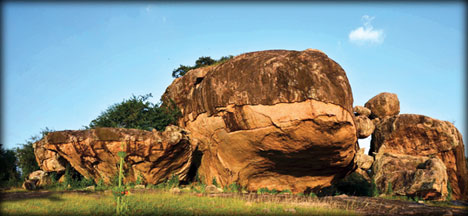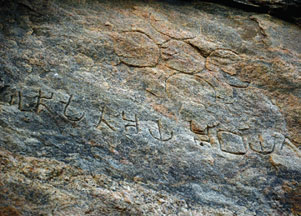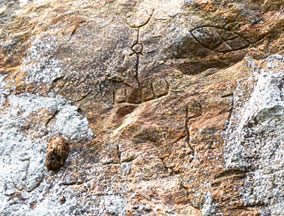 |
|
The Bovattagala rock
boulder |
Bovattagala – a cave complex in the wild
by Ranil WIJESINGHE
It is late afternoon and we can see the silhouette of trees with dead
branches jutting out against a cloudless sky. On the rock boulder, the
orange rays of the sun are reflected in the Kumana Wewa. There is a soft
hush in the air.
We climb the flat rocky terrain in Kumana through the dense jungle.
Birds including hawk-eagles and spoon-bills are on tree-tops. Suddenly,
I glimpse a hawk-eagle take wing, flying towards its prey on the rock as
we break the silence of the quiet environs. The sun starts setting over
the Kumana Wewa in a burst of orange colour.
The destination of my group was Bovattagala, about 11 kilometres
inland from the Kumana Wewa, in the southernmost tip of the Kumana
National Park. The Bovattagala crop, a huge, flat rock boulder where the
ruins of a Buddhist monastery are seen, is said to belong to the Third
Century. It contains a cluster of drip-ledged caves and a number of rock
inscriptions. From the top of Bovattagala, the endless panorama of the
Kumana Wewa and the sanctuary can be seen.
Our tracker Gayan, who has an eye for detail, takes us to the
Bovattagala site where we find an ancient flight of steps, carved out of
the rock, leading to the top of the rock.
 |
|
The arrow-like cave |
 |
|
An inscription |
 |
|
The ruins at the site |
Today, the flight of steps is severely disfigured due to the passage
of time. We follow the same route to climb the rock as the ancient
Bhikkhus did.
On the summit of Bovattagala is an extensive area of flat rock
surface.
On the cliff of the Bovattagala rock boulder in front of the caves,
the Kumana Wewa glistening in emerald hues is a sight to behold while
the perennial carpet of trees and bushes cover the area. On the flat
rocky surface of Bovattagala, Gayan shows us two rock inscriptions and
an image of a stupa carved from the rock. From the summit, the
picturesque Kumana Wewa is visible, in the distance. The Wewa was a main
irrigation tank providing water to cultivate paddy for the inhabitants
of Kumana decades ago.
Agro-based livelihood
In ancient times, there was an anicut built across the Kumbukkan Oya
at a place called Mahagal Amuna to divert water to the Kumana Wewa to
irrigate the area. This is clear evidence that there had been an
agro-based livelihood in Kumana.
“A stupa was once believed to have stood over there,” said Gayan,
pointing to a heap of rubble on the summit overgrown with creepers.
There were ancient bricks and broken carved stones scattered everywhere,
indicating that the stupa has been demolished by treasure hunters in the
recent past.
The most striking feature of the site is the cluster of drip-ledged
caves and the Brahmin inscriptions and drawings carved on the rock
surface about 25 feet above ground. Observing the inscriptions, I
realised that they are thickly carved into the rock and the drawings
have solidity. Even today, most of these inscriptions and drawings are
clear although many centuries have passed.
The Bovattagala rock lies in a somewhat higher altitude and consists
of several caves and remnants of brick-walls around it. These caves have
been bestowed on Bhikkhus in ancient times. There is evidence that these
caves have been reused in later years. Archaeologists believe that some
of these ruined brick-walls belonged to the latter part of the Third
Century BC.
One of the caves in Bovattagala contains a drawing of an awesome
figure which looks like a ghost and has six fingers in one hand.
Archaeologists believe that it is the work of a veddah who inhabited
these caves in later years. Another cave has a drawing of a fish, giving
the impression that the site had been associated with fishing. In fact,
fishing for food started with pre-historic man and became an important
economic activity. One of the inscriptions dating from the Third Century
BC to the First Century AD is of a fish.
Since a proper archaeological survey or research has not been carried
out about the site, the history of Bovattagala is yet to be discovered.
However, some of the rock inscriptions give significant clues to the
historical background of the place. The history of Bovattagala dates
back to the Third Century BC. It was a reputed Buddhist monastery in the
Third Century BC and was venerated by the 10 noble brothers of
Kataragama, known as the Kataragama Kshathriya. These royals are
believed to have ruled the Southern and Eastern Provinces of Sri Lanka
under the regime of the King in Anuradhapura.
Jaya Sri Maha Bodhi
These princes of southern Sri Lanka took part in the festival in
Anuradhapura in celebration of the arrival of the Sacred Jaya Sri Maha
Bodhi in Sri Lanka. They had received one of the first eight plants to
shoot from the Sacred Bodhi Tree which was believed to have been planted
in Kataragama. According to archaeologists, one inscription at the site
says that the Bodhi tree had been planted in Bovattagala.
 |
|
More inscriptions |
 |
|
The majestic sight of
the hawk-eagle |
History also notes that kings and provincial rulers had done yeoman
service to the monastery. Another inscription indicates that the
Minister in the name of Naka, King Mahasen and King Jetta Tissa had made
various contributions to the Bovattagala monastery.
The beauty of the Bovattagala caves has been spoilt by human beings,
however, with the most horrifying sight being the names and addresses
scribbled on the rock ceiling in Sinhala and Tamil, by visitors to the
site. It is believed that these scribblings may have been carried out by
poachers or Tiger terrorists who made these caves their hideout inside
the Kumana jungle. Unfortunately, these letters are in non-erasable ink.
In addition to the main caves, there lies another isolated cave a few
feet away from the main cave, formed like an arrow with both sides open.
A little beyond this cave lies a natural pond and ruins of a stone
foundation of a huge building. The ruins of the monastery are scattered
on the summit of Bovattagala. Today, the place is deserted and lies
majestically amidst the thick jungle of Kumana, and has become home to
wild beasts.
Pix: Mahil Wijesinghe and Susantha Wijegunasekara
|



